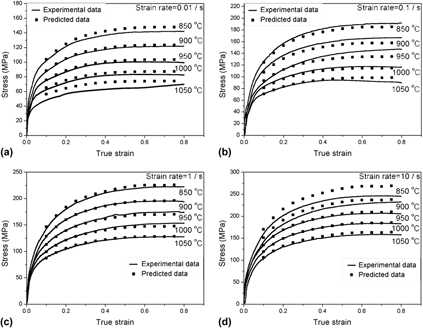Crossref Citations
This article has been cited by the following publications. This list is generated based on data provided by
Crossref.
Zhong, Liwei
Gao, Wenli
Feng, Zhaohui
Lu, Zheng
and
Mao, Guoling
2018.
Microstructure characteristics and constitutive modeling for elevated temperature flow behavior of Al–Cu–Li X2A66 alloy.
Journal of Materials Research,
Vol. 33,
Issue. 8,
p.
912.
Chen, Jianguo
Liu, Yongchang
Xiao, Yantong
Liu, Yihuan
Liu, Chenxi
and
Li, Huijun
2018.
Improvement of High-Temperature Mechanical Properties of Low-Carbon RAFM Steel by MX Precipitates.
Acta Metallurgica Sinica (English Letters),
Vol. 31,
Issue. 7,
p.
706.
Mao, Chunliang
Liu, Chenxi
Yu, Liming
Li, Huijun
and
Liu, Yongchang
2018.
Mechanical properties and tensile deformation behavior of a reduced activated ferritic-martensitic (RAFM) steel at elevated temperatures.
Materials Science and Engineering: A,
Vol. 725,
Issue. ,
p.
283.
Jia, Chao-hang
Liu, Chen-xi
Liu, Yong-chang
Li, Chong
and
Li, Hui-jun
2019.
Microstructural evolution and constitutive models of 9CrMoCoB heat-resistant steel during high-temperature deformation.
Journal of Iron and Steel Research International,
Vol. 26,
Issue. 11,
p.
1228.
Li, Shikang
Li, Luoxing
He, Hong
and
Wang, Guan
2019.
Influence of the deformation heating on the flow behavior of 6063 alloy during compression at medium strain rates.
Journal of Materials Research,
Vol. 34,
Issue. 2,
p.
309.
Shao, Yi
Li, Xiaohua
Ma, Junjie
Liu, Chenxi
and
Yan, Zesheng
2019.
Microstructure Formation of Low-Carbon Ferritic Stainless Steel during High Temperature Plastic Deformation.
Metals,
Vol. 9,
Issue. 4,
p.
463.
Mao, Chunliang
Liu, Chenxi
Yu, Liming
Li, Huijun
and
Liu, Yongchang
2019.
The correlation among microstructural parameter and dynamic strain aging (DSA) in influencing the mechanical properties of a reduced activated ferritic-martensitic (RAFM) steel.
Materials Science and Engineering: A,
Vol. 739,
Issue. ,
p.
90.
Chen, Jianguo
Liu, Chenxi
Wei, Chen
Liu, Yongchang
and
Li, Huijun
2019.
Study on microstructure and mechanical properties of direct diffusion bonded low-carbon RAFM steels.
Journal of Manufacturing Processes,
Vol. 43,
Issue. ,
p.
192.
Chen, Jian-Guo
Liu, Chen-Xi
Wei, Chen
Liu, Yong-Chang
and
Li, Hui-Jun
2019.
Effects of Isothermal Aging on Microstructure and Mechanical Property of Low-Carbon RAFM Steel.
Acta Metallurgica Sinica (English Letters),
Vol. 32,
Issue. 9,
p.
1151.
Li, Xiaohua
Liu, Yongchang
Gan, Kefu
Dong, Ji
and
Liu, Chenxi
2020.
Acquiring a low yield ratio well synchronized with enhanced strength of HSLA pipeline steels through adjusting multiple-phase microstructures.
Materials Science and Engineering: A,
Vol. 785,
Issue. ,
p.
139350.
Liu, Chenxi
Gao, Yan
Li, Xiaohua
Li, Wenchao
and
Gan, Kefu
2020.
Study on microstructure and mechanical property of linear friction welding on 9Cr reduced activation ferrite/martensite steel.
Journal of Nuclear Materials,
Vol. 531,
Issue. ,
p.
152011.
Zhang, Jing-Yu
Tang, Yao
Zhou, Hui-Min
Chen, Qiang
Zhou, Jie
and
Meng, Yi
2021.
Investigation on thermal rheological behavior and processing map of 30CrMnSiNi2A ultra-strength steel.
International Journal of Material Forming,
Vol. 14,
Issue. 4,
p.
507.
Churyumov, Alexander
Kazakova, Alena
and
Churyumova, Tatiana
2022.
Modelling of the Steel High-Temperature Deformation Behaviour Using Artificial Neural Network.
Metals,
Vol. 12,
Issue. 3,
p.
447.
Wang, Xuan
Chen, Jianguo
Guo, Yong
and
Niu, Weifei
2022.
Effects of Heating Rate on Austenitic Transformation and Corrosion Property of High Chromium Ferritic/Martensitic Steel.
International Journal of Electrochemical Science,
Vol. 17,
Issue. 8,
p.
220818.
Huang, Xiaoyu
Wang, Heng
Chen, Jianguo
Dang, Lihua
Ma, Zhongqiang
and
Cui, Shibo
2022.
Effects of Austenitizing Temperature on Microstructure Evolution and Corrosion Resistance of High Cr Ferritic/Martensitic Steel.
International Journal of Electrochemical Science,
Vol. 17,
Issue. 8,
p.
220833.
Zhao, Bo
Xia, Min
Wang, Jun-Feng
and
Ge, Chang-Chun
2022.
Effect of Rare Earth Elements on Microstructure and Hot Workability of AISI T15 High Speed Steel.
ISIJ International,
Vol. 62,
Issue. 11,
p.
2410.
Tong, Yue
Lin, Gaoyong
Wu, Yu
Pan, Qianfu
Zhuo, Hong
and
Liu, Huiqun
2023.
Constitutive Equation for the Hot Deformation and Microstructure Evolution of 12Cr‐F/M Steel.
steel research international,
Vol. 94,
Issue. 9,
Zhao, Bo
Xia, Min
Ge, Chang-Chun
and
Wu, Ming-Yu
2023.
Research on hot deformation behaviour of as-cast W12Cr4V5Co5 steel.
Ironmaking & Steelmaking,
Vol. 50,
Issue. 6,
p.
658.
Zheng, Yan
Kang, Jian
Zhao, Yang
Jia, Guanglin
and
Yuan, Guo
2024.
Numerical study of the secondary cooling scheme in the high-speed continuous casting process of billet.
The International Journal of Advanced Manufacturing Technology,
Vol. 135,
Issue. 3-4,
p.
1419.
Li, Pu
Guan, Tian-hao
Li, Yi-hang
Dang, Ning
Zhao, Feng
and
Suo, Tao
2025.
Coupling effect of strain rate and temperature on deformation mechanism of reduced activation ferritic/martensitic steel.
Journal of Iron and Steel Research International,




